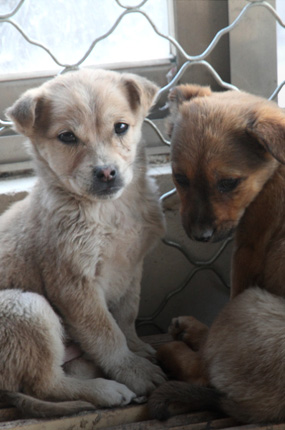


We arrive with our translator at around 8 in the morning. We stayed in Jining, not very far from the farm. The people we stayed with were waiting for us in a car and we followed them to the farm which was just outside the city. Once inside, they took us to an office where we discuss business for nearly an hour. We tell them that we wish to make a weekly purchase of a large quantity of dogs that we will then process in our new meat facility in Guangzhou. They assure us that they can provide the number of dogs that we require.
We persuade them to show us the installations and the condition of the animals, since we need to have a good knowledge of our future suppliers.
We are shown two warehouses, one of which holds around ten large dogs, in separate kennels. In the entrance to one of them is a bucket of oatmeal. That is all the food that they have. These are the adults used for breeding. We see Samoyeds, greyhounds, Alaskan Malamutes and crossbreeds with American Staffordshire terrier, German shepherd and Shibu Inu origins. It seems that they spend a lot of time in enclosed condition and they bark at us non-stop. Many of them seem to be looking to us for affection, and others barked nervously. One of the dogs, which looks like a German Shepherd, clearly has injured back paws and is unable to get up or even pull itself along, and it looks at us with interest. Another dog still has a collar around its neck, from its previous owners. These dogs have been stolen from families in the area.
Through what we witnessed and conversations we had with our translator, we now know that this network has a criminal faction whose role is to steal dogs from their homes and from the streets. Questioned directly about their capacity to provide us with the number of dogs we require on a weekly basis, they confirm that if necessary they would conduct searches in the region for street dogs. They themselves would take care of sending them to us.
In the other warehouse there are approximately 150 puppies of only several weeks of age. We notice several wire cages on the ground into which puppies are crammed. The cages are approximately 80cm wide by 40cm tall and 20cm deep. We count up to 13 puppies per cage. We are told that these puppies are sold at 3 weeks of age to another farm where they are fattened up until they reach the weight requirement, or else, they are slaughtered here – by stabbing, without being stunned beforehand, as it is explained to us – or they are taken by lorry to one of the other slaughterhouses they deal with.
One of us, accompanied by the translator, distracts the farmers with a barrage of questions whilst someone else uses this opportunity to film as much as possible. Before we leave, we ask once again to be given another look. We feel that we are taking a big risk by asking and forcing the situation in this way, so that we can film some more, but we consider that now that we have succeeded in infiltrating this group and have got this far, we need to be sure that we have enough material. We can’t go away without getting this.
The farmers don’t seem to suspect anything. In any case, the two investigators established a series of key words which, once pronounced by any one of us, allow us to communicate the level of risk of the situation and to act accordingly. One of these words would serve as an instruction to get out immediately, losing no time whatsoever.
Before coming to China we contacted various activists who had investigated this business in the past. The most experienced of them told us that he had stopped investigating these places several years earlier. It was too dangerous. He warned us that we could end up stabbed and dumped in a ditch. In this farm, in the middle of nowhere, I remember what he said and try to remain calm and act in accordance with our cover story. Keep moving forward. This is our only option.
